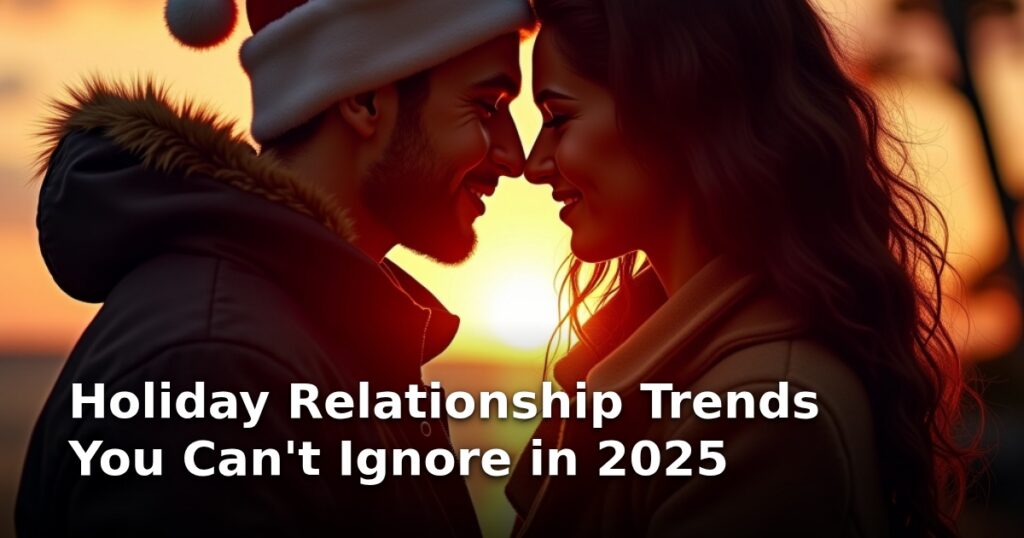Holiday Relationship Trends You Can't Ignore in 2025
The transition into the holiday season, often extending well into the new year, remains a crucible for romantic relationships. As external pressures—financial strain, packed social calendars, and family obligations—intensify, the need for proactive holiday relationship advice becomes paramount. Understanding the emerging relationship dynamics of 2025 is crucial for couples seeking not just to survive this period, but to genuinely thrive. This analysis outlines the key relational trends shaping how modern couples connect, conflict, and commit during high-stress seasons.
The Current Landscape: Pressure Cooker Dynamics
The modern holiday period is characterized by heightened expectations fueled by social media perfection and lingering pandemic-era anxieties about connection quality. Data from relationship counseling services indicates a consistent 20-30% spike in relationship conflict reports between Thanksgiving and Valentine's Day. This period tests the foundational pillars of partnership, forcing couples to confront issues related to boundaries, time allocation, and differing needs for intimacy. Ignoring these pressures leads to predictable erosion of connection, making trend identification essential for preventative maintenance.
Trend 1: The Rise of "Intentional Disconnection" as a Boundary Tool
One of the most significant shifts we observe is the deliberate move away from mandated, constant togetherness toward scheduled, high-quality solitude.
What the Trend Is
Couples are increasingly recognizing that "forced fun" during the holidays can be detrimental. Intentional Disconnection involves setting firm, mutually agreed-upon times for individual decompression, often involving solo activities or time with separate friendship groups. This is a direct counter-movement to the expectation that partners must be joined at the hip throughout the entire festive period.
Evidence and Emergence
Surveys suggest that 65% of adults report feeling "over-socialized" by January 1st. This trend is emerging now because, post-2020, individuals have a stronger sense of personal capacity limits. Furthermore, the integration of flexible work schedules means the physical presence of a partner is constant, making mental separation more vital than ever.

Impact and Preparation
The immediate impact is reduced friction over differing holiday energy levels. For couples struggling with effective communication in marriage, this trend provides a tangible, low-stakes starting point: negotiating alone time rather than arguing over who needs a break. Preparation involves clearly articulating "recharge needs" before the holiday rush begins, treating individual downtime as a non-negotiable appointment.
Trend 2: Navigating the "In-Law Visibility Index"
Family obligations remain the single largest source of holiday conflict, but the nature of this stress is evolving due to increased transparency in family dynamics.
What the Trend Is
The In-Law Visibility Index refers to the quantified, pre-negotiated level of exposure a couple agrees to have with extended families. This goes beyond simply scheduling visits; it includes setting boundaries around sensitive topics, digital sharing of family events, and the duration of stays.
Evidence and Emergence
Clinical psychologists report a rise in "boundary fatigue," where previously unspoken family expectations are now being actively challenged. With younger generations prioritizing mental health, the societal pressure to "keep the peace" at all costs is diminishing. Managing in-law relationship stress is no longer about appeasement; it’s about strategic partnership.
Implications and Capitalization
When couples present a united front on these boundaries, their relationship strength increases. Conversely, a lack of alignment is quickly exploited by external family members. Capitalizing on this trend requires pre-season strategy sessions focused entirely on external relationship management, ensuring both partners are briefed on the agreed-upon defense strategies for sensitive topics like career changes or future planning.
Trend 3: The "Burnout Bridge"—Signs Your Partner is Pulling Away Under Pressure

The pressure of year-end deadlines often masks deeper relational issues, making it harder to discern true disconnection from temporary stress.
What the Trend Is
This trend focuses on identifying subtle, work-induced withdrawal that mimics deeper relationship problems. We are seeing an increase in partners exhibiting classic signs your partner is pulling away—reduced emotional availability, shorter texts, delayed responses—but the root cause is acute professional burnout, not romantic dissatisfaction.
Supporting Data
While anecdotal evidence is high, longitudinal studies tracking emotional responsiveness during peak Q4 stress show a measurable dip (up to 40% reduction in unsolicited affection) in partners holding high-stakes roles. The challenge lies in differentiating this temporary "burnout bridge" from genuine detachment.
How to Respond Strategically
The key here is diagnosis before reaction. Instead of assuming malice or disinterest, partners must employ curiosity. Staying connected during stressful work periods requires shifting from demanding emotional engagement to offering practical support. This might mean handling logistics or providing uninterrupted quiet space, rather than seeking deep conversation until the pressure subsides.
Emerging Trends to Watch in Early 2025
Beyond the immediate holiday rush, two trends signal shifts in commitment strategy for the new year:
1. The "Micro-Date Renaissance"
As the novelty of grand New Year's resolutions fades, couples are prioritizing extremely short, highly focused connection points. These "micro-dates" (e.g., 15 minutes of device-free coffee before work, a 10-minute debrief before bed) are proving more sustainable than large, infrequent gestures. This speaks to a growing realization that consistency trumps intensity.

2. The Re-Evaluation of "Couple Identity"
After the high-intensity socializing of the holidays, many couples engage in a quiet "couple identity audit." They assess whether their shared goals and visions for the coming year remain aligned. This often surfaces as the impetus for seeking dating advice for the new year, focusing on rekindling shared hobbies or establishing new joint projects that reinforce their "we" identity outside of family obligations.
Future Predictions: The Normalization of Digital Boundaries
By 2026, we predict that relationship counseling will standardize the creation of "Digital Downtime Contracts" that apply year-round but are most strictly enforced during holidays. These contracts will detail acceptable response times for work emails versus personal messages, and establish "no-phone zones" in shared intimate spaces. This reflects a societal understanding that technology management is now synonymous with relationship management.
Strategic Recommendations for Navigating 2025
To successfully navigate the complex relational terrain of the upcoming holiday season, couples should adopt a proactive, strategic posture:
- Schedule the Solitude First: Before planning any joint activities, explicitly schedule individual recharge time. This preempts resentment and honors differing needs for processing the holiday influx.
- Conduct a Pre-Season Family Summit: Dedicate one meeting solely to managing in-law relationship stress. Agree on talking points, exit strategies for difficult conversations, and ensure you are presenting a unified front on all boundary issues.
- Practice Empathetic Inquiry: When you notice signs your partner is pulling away, respond with, "I notice you seem stressed lately; how can I best support you right now?" rather than, "Why aren't you paying attention to me?" This distinction is vital for staying connected during stressful work periods.
- Prioritize Micro-Connections: Recognize that grand gestures often fail under pressure. Focus your holiday relationship advice implementation on small, consistent acts of presence. A meaningful five-minute check-in is more valuable than a strained three-hour dinner.
- Seek Targeted Advice: If the stress feels overwhelming, consult resources or therapists specifically for dating advice for the new year focusing on post-holiday recalibration, rather than waiting for a crisis in February.
The 2025 holiday season will test relationships, but it also offers profound opportunities for growth. By recognizing these key trends—intentional disconnection, strategic boundary setting, and empathetic response to burnout—couples can transform potential conflict points into powerful opportunities for deeper, more resilient connection.



